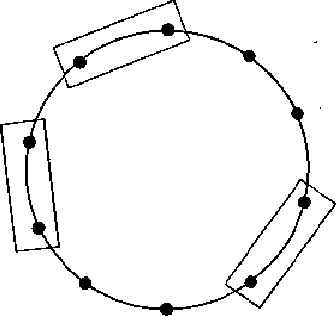 of ways of seating
of ways of seating  couples around a circular table, so that no one sits next to his or her
partner. This is nearly the same as the ménage problem, only now we
have relaxed the requirement that men and women alternate.
couples around a circular table, so that no one sits next to his or her
partner. This is nearly the same as the ménage problem, only now we
have relaxed the requirement that men and women alternate.
We begin with an apparently simpler problem, called the relaxed
ménage problem, which asks for the number  of ways of seating
of ways of seating  couples around a circular table, so that no one sits next to his or her
partner. This is nearly the same as the ménage problem, only now we
have relaxed the requirement that men and women alternate.
couples around a circular table, so that no one sits next to his or her
partner. This is nearly the same as the ménage problem, only now we
have relaxed the requirement that men and women alternate.
To determine  , we begin with the set
, we begin with the set  of all
of all  ways of
seating the
ways of
seating the  individuals around the table, and use inclusion-exclusion
on the set of couples who end up sitting together. Let us
call the elements of
individuals around the table, and use inclusion-exclusion
on the set of couples who end up sitting together. Let us
call the elements of  seatings, and let us denote by
seatings, and let us denote by  the number
of seatings under which some specified set of
the number
of seatings under which some specified set of  couples (and
possibly some other couples) end up sitting together. Clearly,
couples (and
possibly some other couples) end up sitting together. Clearly,  does not depend on the particular set of
does not depend on the particular set of  couples we choose, and so,
by the principle of inclusion and exclusion, we have
couples we choose, and so,
by the principle of inclusion and exclusion, we have

To finish the enumeration, we must compute  . Assume
. Assume  . Let
. Let  denote the number of ways of placing
denote the number of ways of placing  non-overlapping unlabeled
dominos on
non-overlapping unlabeled
dominos on  vertices arranged in a circle.
(See Figure 1.)
vertices arranged in a circle.
(See Figure 1.)

Figure 1: Non-overlapping dominos
Then

(Decide where the  couples go, and which couple goes where, and
which partner
takes which seat, and where the
couples go, and which couple goes where, and
which partner
takes which seat, and where the  individuals go.) So now we
have only to
compute the
individuals go.) So now we
have only to
compute the  's. This is a routine combinatorial problem. The
answer is
's. This is a routine combinatorial problem. The
answer is

(See Ryser [11], pp. 33-34, or Exercise 1 below). This yields

Plugging this expression for  into the formula for
into the formula for  , above, we
get
, above, we
get

By symmetry, we know that  , must be divisible by
, must be divisible by  .
Pulling
this factor out in front, we can write
.
Pulling
this factor out in front, we can write

The first few values of  are shown in Table 1.
are shown in Table 1.